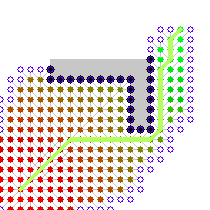参考链接1:https://www.cnblogs.com/xiaochi/p/8671740.html
参考链接2:http://www.mamicode.com/info-detail-2486552.html
在宽度优先和深度优先搜索里面,我们都是根据搜索的顺序依次进行搜索,可以称为盲目搜索,搜索效率非常低。
而启发式搜索则大大提高了搜索效率,由这两张图可以看出它们的差别:


(左图类似与盲搜,右图为启发式搜索)
很明显启发式的搜索效率远远大于盲搜。
什么是启发式搜索(heuristic search)
利用当前与问题有关的信息作为启发式信息,这些信息是能够提升查找效率以及减少查找次数的。
如何使用这些信息,我们定义了一个估价函数 h(x) 。h(x)是对当前状态x的一个估计,表示 x状态到目标状态的距离。
有:1、h(x) >= 0 ; 2、h(x)越小表示 x 越接近目标状态; 3、如果 h(x) ==0 ,说明达到目标状态。
与问题相关的启发式信息都被计算为一定的 h(x) 的值,引入到搜索过程中。
然而,有了启发式信息还不行,还需要起始状态到 x 状态所花的代价,我们称为 g(x) 。比如在走迷宫问题、八数码问题,我们的 g(x) 就是从起点到 x 位置花的步数 ,h(x) 就是与目标状态的曼哈顿距离或者相差的数目;在最短路径中,我们的 g(x) 就是到 x 点的权值,h(x) 就是 x 点到目标结点的最短路或直线距离。
现在,从 h(x) 和 g(x) 的定义中不能看出,假如我们搜索依据为 F(x) 函数。
当 F(x) = g(x) 的时候就是一个等代价搜索,完全是按照花了多少代价去搜索。比如 bfs,我们每次都是从离得近的层开始搜索,一层一层搜 ;以及dijkstra算法,也是依据每条边的代价开始选择搜索方向。
当F(x) = h(x) 的时候就相当于一个贪婪优先搜索。每次都是向最靠近目标的状态靠近。
人们发现,等代价搜索虽然具有完备性,能找到最优解,但是效率太低。贪婪优先搜索不具有完备性,不一定能找到解,最坏的情况下类似于dfs。
这时候,有人提出了A算法。令F(x) = g(x) + h(x) 。(这里的 h(x) 没有限制)。虽然提高了算法效率,但是不能保证找到最优解,不适合的 h(x)定义会导致算法找不到解。不具有完备性和最优性。
几年后有人提出了 A*算法。该算法仅仅对A算法进行了小小的修改。并证明了当估价函数满足一定条件,算法一定能找到最优解。估价函数满足一定条件的算法称为A*算法。它的限制条件是 F(x) = g(x) + h(x) 。 代价函数g(x) >0 ;h(x) 的值不大于x到目标的实际代价 h*(x) 。即定义的 h(x) 是可纳的,是乐观的。
不同的估价函数对算法的效率可能产生极大的影响。尤其是 h(x) 的选定,比如在接下来的八数码问题中,我们选择了曼哈顿距离之和作为 h(x) ,你也可以选择相差的格子作为 h(x),只不过搜索的次数会不同。当 h(x) 越接近 h*(x) ,那么扩展的结点越少!
用boost的图论库编辑代码如下:
#include <iostream> #include <string> #include <utility> #include <vector> #include <deque> #include <boost/graph/adjacency_list.hpp> #include <boost/graph/astar_search.hpp>//A*寻路算法 using namespace std; using namespace boost; enum { A, B, C, D, E, N }; string Names = "ABCDE"; //定义别名,两个顶点直接连接的边 using Edge = pair<int, int>; //创建一个图 边 顶点 有方向 无特性 边的权重是int using Graph = adjacency_list<listS, vecS, directedS, no_property, property<edge_weight_t, int>>; //创建一个图 Graph make_graph() { //连接的边 vector<Edge> edges = { {A,B}, {A,C},{A,D},{B,E},{C,E},{D,E} }; //边对应的权重 vector<int> weight = { 3,1,4,5,2,6 }; //创建一个图对象 return Graph(edges.begin(), edges.end(), weight.begin(), N); } //创建一个结构体,用于抛出找到信息 struct found_goal { }; //A*要到达的目标顶点 template<class vertex> class astar_my_visitor :public boost::default_astar_visitor { public: //初始化内置地图 astar_my_visitor(vertex goal) :m_goal(goal) { } //重载examine_vertex方法 template<class Graph> void examine_vertex(vertex v, Graph &g) { //如果与目标顶点一样,则说明找到 if (v == m_goal) { //抛出抛出找到信息 throw found_goal(); } } private: //目标顶点 vertex m_goal; }; //计算权重寻找最短路径 template<class Graph,class costtype> class distance_heuristic :public boost::astar_heuristic<Graph, costtype> { public: //类型替换 using Vertex = typename boost::graph_traits<Graph>::vertex_descriptor; //初始化 distance_heuristic(Vertex Goal, Graph &graph):Goal_(Goal),graph_(graph) { } //重载()运算符 获得目标点到指定点的距离 costtype operator()(Vertex v) { return get(vertex_index, graph_, Goal_) - get(vertex_index, graph_, v); } private: Vertex Goal_; Graph &graph_; }; int main() { //创建图 Graph myg = make_graph(); //创建简写 using Vertex = boost::graph_traits<Graph>::vertex_descriptor; using Cost = int; Vertex start = vertex(A, myg);//开始位置 Vertex goal = vertex(E, myg);//结束位置 //保存走过路径(由后向前) vector<Vertex>parents(boost::num_vertices(myg)); //保存长度 vector<Cost>distance(boost::num_vertices(myg)); try { //求从指定点到终点的路线 boost::astar_search_tree(myg, start, distance_heuristic<Graph, Cost>(goal, myg),//传递距离 //求出路径,以及路径对应的权重,访问器访问 因为重载了()运算符 boost::predecessor_map(&parents[0]).distance_map(&distance[0]).visitor(astar_my_visitor<Vertex>(goal)) ); } //catch信息 catch (found_goal fg) { //要到的位置的前一个到达的位置如果是goal(下标是当前点,值是到这个点之前的点) if (parents[goal] == goal) { cout << "无路可走" << endl; } deque<Vertex> route; //顺藤摸瓜 for (Vertex v = goal; v != start; v = parents[v]) { route.push_front(v); } cout<<"从"<<Names[start]<<"到"<<Names[goal]<<"的最短路径为:"<<endl; cout << Names[start]; for (auto i : route) { cout <<"->"<< Names[i]; } cout<<endl; } return 0; }
运行结果如图
